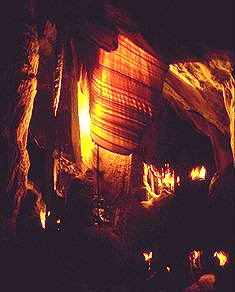Curtain
Cave Curtain - Draperies - Shawl - Bacon Rind
A Curtain is a calcite formation in the form of a wavy or folded sheet hanging from the roof or wall of a cave.


A curtain forms when water runs down the roof or the wall of the cave. If the ceiling is nearly horizontal, the water will form a stalactite, if the wall is nearly vertical, the water will form a sinter galery. But if the angle is in between - about 45° - the water will not fall down, but run down the wall. It will always use the same path. While the water runs down the wall, it loses carbon dioxide (CO2) to the atmosphere of the cave and as a result precipitates calcite in a thin vertical line on the wall. This line grows and grows, and soon there is a small rim. Once there is this small rim, the water has no possibility to leave its path. It always follows this path like a train follows its tracks.
Curtains are normally translucent and resonant. Both characteristics depend on the thickness (or thinness) of the curtain. As the curtain grows from a very thin line - as thin as a drop running down the wall - it normally is very thin. And as it consists of small calcite crystals, it is translucent. The climate on the surface changes, the amount of water in the cave does also. So there are short periods like the seasons and much longer periods like changing sun spot activity. All changes in the amount of water change the relation calcite/iron oxide and therefore the colour of the depositing calcite crystals. And as the curtain grows in layers, there are stripes inside the curtain. Normally, you can follow them fron the beginning to the end of the curtain. These stripes are the reason why this formation is often called bacon or bacon rind, it resembles bacon, which has stripes of fat and meat.
 Search DuckDuckGo for "Cave+Curtain"
Search DuckDuckGo for "Cave+Curtain" Draperies (visited: 19-OCT-2024)
Draperies (visited: 19-OCT-2024)
 Index
Index Topics
Topics Hierarchical
Hierarchical Countries
Countries Maps
Maps